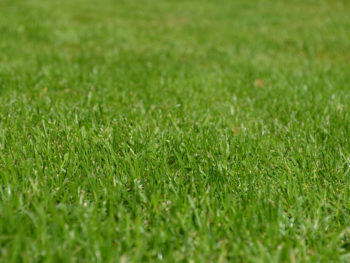Having a lush green lawn is a source of pride and pleasure for many homeowners, but as we all know, lawns are thirsty and maintaining them takes a lot of water. In a country like Australia, where water levels can often be a problem and many places operate on water restrictions, it’s important to know the most efficient way to water your lawn – saving you not only water but also money.
Frequency
How often your lawn needs a drink depend on a variety of factors – things like regional climate, season, current weather, soil type, grass type and amount of sunlight it receives. Take all these factors into consideration when deciding how much to water your lawn (consult your local turf suppliers at Horsham Turf for advice on your specific lawn type and area) but keep in mind the rule of thumb – only water your lawn when it needs it.
Having said that, here are a few tips to keep in mind. Watering every day or every other day is not a good idea, as excessive water leads to a shallow root system and a greater chance of diseases. Water deeply 2 – 3 times per week, rather than daily. The lawn should be allowed to partially dry out between waterings to stimulate deeper root formation, let air into the root system and create a more drought-resistant lawn.
You won’t need to water well-established turf as much as newly-laid turf. Over the first few months after laying your new lawn, you can gradually reduce the number of times you water the lawn and how long you water it.
When to water
Early in the morning (between 4.00am and 10.00am) is the best time to water your lawn, as the air is cooler and calmer than other times and evaporation is less of a problem than if you water later in the day. Watering at night is not a good idea either, as water sitting on the grass overnight can lead to fungus and diseases.
Depth
Water your lawn to a depth of about 6 inches down – the depth of a healthy grass root system. To check the depth of the water initially, check the soil every 15 minutes by lifting up a patch of grass with a shovel. Time how long it takes the water to penetrate 6 inches down, and water for that duration of time in the future, as each lawn is different and you need to water to suit your own lawn.
Watering in different seasons
Your lawn, like many other plants, grows differently in each of the four seasons. You will need to adjust the watering of your lawn as the seasons change, to get the best results from your turf.
Winter watering
You need to be sure you don’t overwater the lawn in winter, because a wet lawn can rot when it’s cold. However, sometimes the opposite problem occurs and it can be surprising how dry the lawn can get in winter. You will need to monitor moisture levels by feeling deep into the thatch, and only water if it feels dry. It is especially important to make sure you water the lawn in the morning during the winter months, as water left on the lawn at night can freeze, causing damage. The general rule of thumb is to water minimally in winter, but keep checking your lawn to ensure optimal results.
Spring watering
The soil is just starting to warm up during spring and nights are often still cool, so deep watering may last for longer than expected. To check, use a finger to burrow down into the lawn, and don’t water if it’s damp. Your lawn will generally need to be watered more regularly in spring as the weather begins to heat up.
Summer watering
During excessively hot weather, your grass will need more to drink, as extreme heat, wind and dryness wreak havoc with the lawn. It’s better to increase the amount of water being applied to the lawn at each watering, rather than increase the frequency of watering by watering on more days of the week. Make sure you water earlier than usual while it’s still cool so your lawn can absorb the maximum amount of water before the hot summer sun does its evaporative work. Summer months require the highest frequency of lawn watering – but still keep it to 2 – 3 times per week.
Autumn watering
The lawn can get quite dry at this time of year, as windy weather can be just as drying as a hot day and the frequency of rain often drops off in autumn. While you won’t need to water as often as in summer, keep a check on the moisture levels of the lawn and consider using a soil wetting agent to improve water penetration.
Take all these factors into consideration, but always remember to listen to your lawn, because it will tell you what it needs. Watch out for signs of stress such as grass wilting, seeding or discolouring slightly, as that will tell you your lawn isn’t getting enough water. If your grass is growing excessively then you might need to water a little less until the grass is growing at a moderate rate while maintaining good condition. Your lawn will reward you with a lush display of healthy greenness when you get your watering right.






